Canon EF 200 mm f/2.8L II USM
3. Build quality
You can also try and compare the tested lens to other 70-200 mm f/2.8 class instruments, what we have done in the next chart. It’s clear that the zoom lenses are about two times heavier and noticeably longer.
In the photo below the tested lens is positioned next to two Canons, the EF 50 MM F/1.8 II and the EF 100 mm f/2.8L Macro USM IS.
Please Support UsIf you enjoy our reviews and articles, and you want us to continue our work please, support our website by donating through PayPal. The funds are going to be used for paying our editorial team, renting servers, and equipping our testing studio; only that way we will be able to continue providing you interesting content for free. |
- - - - - - - - - - - - - - - - - - - - - - - - - - - - - - - - - - - - - - - - - - - - - - - -
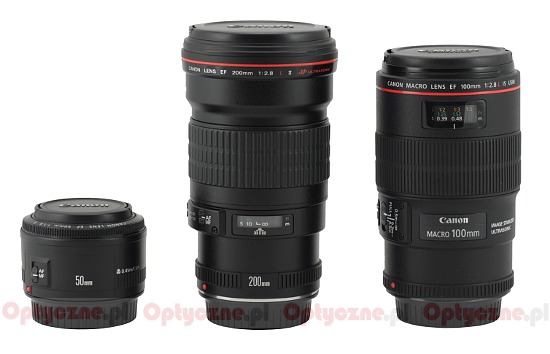 |
The Canon 2.8/200 starts with a metal mount with contacts. Looking inside you see a part of the inner tube; it is padded with black and quite shaggy velour. Its task is to blacken efficiently the interior and catch the dirt which, instead of falling on an element, gathers on the material-covered tube sides. A rear element, which is immobile, remains hidden inside the casing as deep as 3.5 cm and it is about 3 cm in diameter.
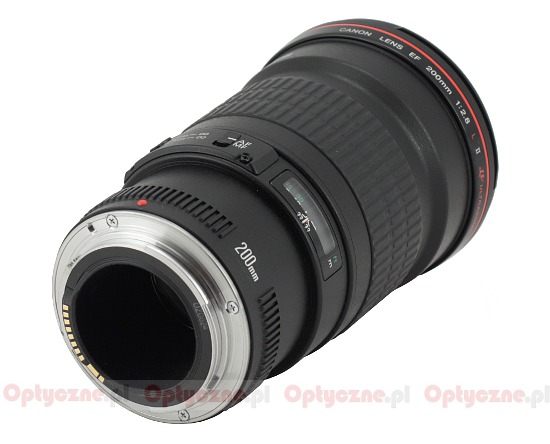 |
Passing onto a black casing, made of magnesium alloys, first we find a narrow, immobile and partially ribbed ring. There is a red dot on it, showing the right position for attaching the lens to a body, and an inscription “200 mm” on the one side and a serial number on the other. A place to fix a tripod adapter is the next part of the casing – unfortunately you don’t get the adapter in the box with the lens.
The next element is a distance scale – it is positioned behind a window and expressed in meters and feet. It includes a depth of field markings but only by f/32 aperture. On the left side of the scale there are several switches: the first one is used to choose the focusing mechanism working mode (AF/MF) and the second one allows you to limit its range (there are two options available: from 1.5 m to infinity and from 3.5 m to infinity).
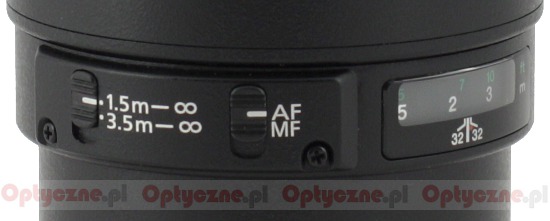 |
Then you can find a big, 44 mm wide, manual focus ring. Its major part is covered by rubber ribbing. The ring moves smoothly and is well-damped. Running through the whole scale takes a turn through 130 degrees - a value a bit too small to ensure really precise manual settings with a shallow depth of field the tested lens can offer.
The next, immobile part of the casing consists of a red stripe, characteristic for the L series, the name and parameters of the lens. The lens itself ends with a hood mount inside which you can also find a non-rotating filter thread, 72 mm in diameter. The front element itself, with a diameter of 7 cm, is a bit convex, hiding only slightly inside the casing.
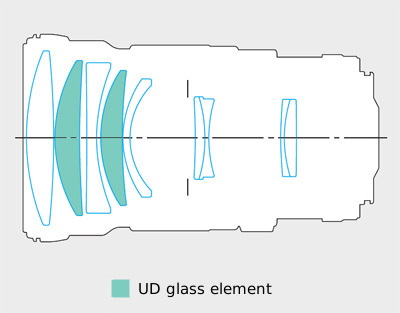
The lens consists of nine elements positioned in 7 groups. Two elements were made of low dispersion UD glass. Inside the construction you can also find a circular aperture with eight diaphragm blades which can be stopped down to the value of f/32.
The buyer gets both caps, a hood and a soft pouch in the box. It is a pity that for such a high price the producer didn’t decided to add a tripod adapter to the accessory kit.
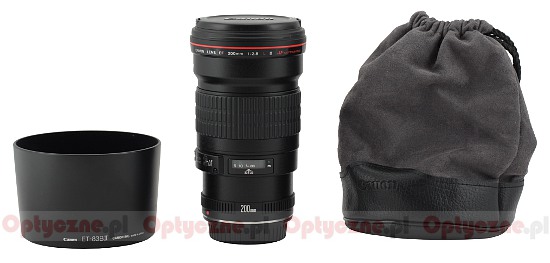 |






